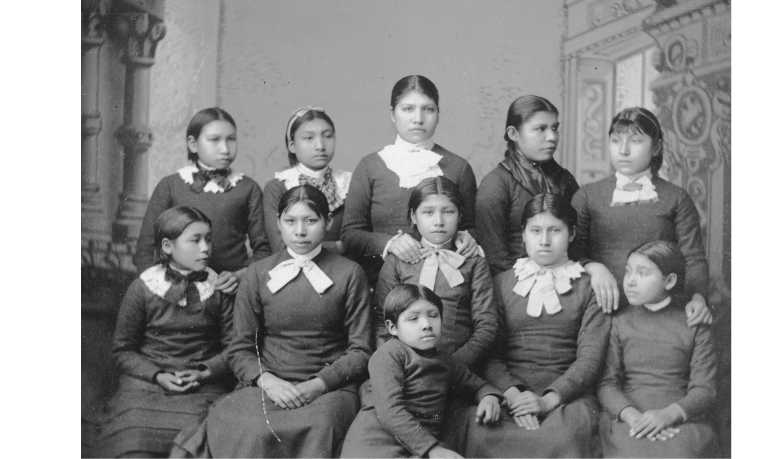It was always an event in the little girl’s life to take a walk with her father, and more particularly so today, because she had on her new winter bonnet, which was so beautiful (and so becoming) that for the first time she woke to the importance of dress, and of herself as a subject for adornment—so that I may date from that hour the birth of the conscious and feminine ME in the little girl’s vague soul.
—Edith Wharton, A Backward Glance
In this book I have provided just a few examples of how colonial individuals in North America manipulated clothing and adornment in their embodiment of self. While these colonial contexts differ quite a bit, they each raise several significant points: first, it was common for people to actively manipulate items of clothing and adornment within colonial contexts; and second, individuals manipulated seemingly mundane items in ways that were meaningful to them. They constituted their identities by producing, exchanging, and using things—that is, in the entanglement of subject and object (Gosden and Knowles 2001:5). The strategies people used in dressing were a way to build identity from the skin outward. Such actions were purposeful, suggesting that hybridity of dress was part of the strategy from the outset of colonial encounters and that creating hybrid fashion was a common colonial experience, shared by people of different ethnic and racial descent living in the American colonies.
The topic of clothing and adornment has been revitalized within historical archaeology by the growth in the literature that examines how sexuality, gender, materiality, and identity are situated on and in the body. Objects are at the center of research related to clothing and adornment: people embodied identity through their use of objects on their bodies. Colonial peoples did not simply hang objects on their bodies to clothe nakedness;
Such actions were purposeful. They embodied their identities through their use of material culture. The objects of clothing and adornment they wore became part of their bodies and were integral to how they constructed their identities for themselves and for others. And because practices of dress through clothing and adornment were so important, they were strictly monitored during the colonial period of North America. Social stigmas, fines, floggings, and even imprisonment were among the punishments meted out for dressing outside of prescribed fashions. Some individuals were forced to dress in a certain way; others carried the physical mark of their body’s ownership by another.
In my discussions of the different strategies people used to dress their bodies, I do not mean to imply that they manipulated dress in every possible instance. Fashion occurred largely in public, where people created dress and identity with certain types of sumptuous and plain material culture. In some cases, they used clothing and adornment in nuanced and conservative ways as they constructed their identities. Barbara Voss argues that people at El Presidio de San Francisco used moderate manipulations of dress and adornment, for example (Voss 2oo8a:252-286; see also Voss 2008b). As she explains, colonial men and women were well aware of colonial sumptuary laws and what it meant to dress properly both at home and in church. At El Presidio de San Francisco, the archaeological record indicates that variation of dress occurred within a very narrow range. Everyday dress for the Californios was plain and their adornment, such as dark gray glass beads, was minimal (Voss 2008b:283). Attending religious services provided the population with an opportunity to dress up, to display wealth and status in more overt ways. Silks and lace did circulate through the community, but the archaeological record from the site indicates that the overall the dress of people at the presidio, regardless of race or status, was modest and did not fully follow the Bourbon fashion that was popular in other parts of New Spain (Voss 2008b:285; see also Loren 2007b for a discussion of dress in eastern New Spain). In addition, the population at El Presidio de San Francisco chose not to incorporate Native California dress styles, such as bone and shell beads and pendants, into their emerging fashions. The modest dress styles of presidio inhabitants and their disinclination to incorporate Native Californian dress into their clothing habits suggests a certain pattern of colonial life regarding the choices people made to create their emergent Californio identities. As Voss (2008b:286) concludes, Californio identity “was achieved as much through emphatic distinction from Native
Californians as it was through challenges to the arbitrary racial hierarchies that permeated the Spanish-colonial Americas.”
Following the American Revolution, standards of dress changed rapidly: from combinations of homespun and imported clothing to the European fashions that influenced the emerging nation so deeply (De Marly 1990:131; Ulrich 2001). Although sumptuary laws were no longer being strictly enforced, dress continued to be monitored and judged as an important aspect of class and identity. Thomas Jefferson expressed as much in a letter to his 11-year-old daughter Martha:
To advise you on the subject of dress, which I know you are a little apt to neglect. I do not wish you to be gaily clothed at this time of life, but that what you wear should be fine of its kind. But above all things and at all times, let your clothes be neat, whole, and properly put on. Do not fancy you must wear them till the dirt is visible to the eye. . . . Some ladies think they may, under the privileges of desha-billee, be loose and negligent of their dress in the morning. But be you from the moment you rise till you go to bed, as cleanly and properly dressed as at the hours of dinner or tea. A lady who is seen as a sloven or a slut in the morning, will never efface the impression she has made, with all the dress and pageantry she can afterwards involve herself in. (quoted in De Marly 1990:137-138)
As America as a concept and as a country grew during the nineteenth century, concerns about clothing and adornment continued but in a slightly different vein. Certain items of clothing and objects of adornment were increasingly mass-produced and distributed to peoples across social classes. Renegotiations of dress and identity were intertwined with the social identities of newly freed African peoples and Native Americans who were subject to federal Indian policies that promoted assimilation during the mid - to late nineteenth century.
One of the most striking examples of the manipulation of dress in a postcolonial context took place in the context of the Indian boarding schools of the nineteenth and twentieth centuries. In 1878, Captain Richard Pratt opened the Carlisle Indian School in Carlisle, Pennsylvania. Between 1880 and 1902, approximately 100 boarding schools were built off reservations to school approximately 30,000 Native American children and force them to assimilate into mainstream white culture (Archuleta et al. 2000; De Cunzo 2006:181).

6.1. Omaha Girls at Carlisle Indian School, ca. 1900. From left: Lettie Esan, Mary Hewett, Elsie Springer, Mary Lyndall, Alice Springer, Etta Webster, Jenny Mitchell, Fanny Mervice, Alice Tremont, Etta Lyndall, and Mamie Springer. Courtesy of President and Fellows of Harvard College, Peabody Museum of Archaeology and Ethnology, 2004.29.5870.
The goal of Indian boarding schools was to remove Native American children from home communities and place them in military-style institutions where traditional ways were replaced by Christian religion, household skills, and industrial trades. To achieve these goals, Native American children were subject to severe bodily changes: they were prohibited from speaking Native American languages, their hair was cut, and they were dressed in uniforms (Figure 6.1). Such alterations had immediate and traumatic impacts on how these children presented and experienced their selves.
The United States Industrial Indian School at Phoenix, Arizona, was one of these institutions where over 900 students from 23 tribes in Arizona, New Mexico, California, Nevada, and Oregon were schooled during the period 1891 to 1905 (De Cunzo 2006:181; Lindauer 1997:1-3). Artifacts recovered from a sanitary landfill that dates to the period 1892-1924 suggest how the students at the Phoenix Indian school developed strategies for incorporating their Native American identities with newly enforced American identities (Lindauer 1996, 1997:46-56). While the landfill provides evidence of the clothing school authorities used to impose conformity and military discipline on the students (brass buttons from uniforms and glass buttons from shirts, dresses, and undergarments), it also provides evidence of the ways that students strove to secretly retain other aspects of Native American identities through concealing and carrying fetishes and effigies on their bodies (Lindauer 1997:18-49; see also Casella 2007). While very little archaeology has been conducted at other Indian boarding schools, one hopes that future archaeologists will be able to investigate these contested institutions to recover similar corporeal and dressing strategies to those found at the Phoenix Indian School, practices Native American children enacted to diminish feelings of isolation from their home communities and identities.
Dress Matters
Dress is a discursive daily practice of constructing and reconstructing one’s identity in a social landscape. Dress occurs at the micro level: colonial-era individuals constituted identity through material culture in relationship to sumptuary laws, imperial definitions of inclusion and exclusion, and lived experiences in colonial worlds (Fisher and Loren 2003). The archaeological record is a key component of interpreting the colonial past because all colonial relations were constituted with material culture (Gosden and Knowles 2001:6).
The work of understanding the clothed, adorned body within the colonial world relies heavily on the use of multiple sources. Material culture and textual and visual sources provide distinct, often contradictory, viewpoints about the nature of dress—how fashion, style, and meaning were embodied. One of the great advantages of interdisciplinary endeavors is that silences and disjunctures between sources can illuminate points of contention about colonial policy and practice (Hall 1992, 2000; Loren and Baram 2007; Stahl 1993). What can we learn of the lives and struggles of colonial peoples from investigating artifact assemblages that at first glance seem to contain unlikely and dissonant combinations of different categories of material culture? The answer lies in comparing artifacts that are present in the assemblage and in comparing the artifacts that have been retrieved with those that are missing, taking note of ways that the remnants of daily practices are or are not represented in historical, visual, and ethnographic material.
As a museum professional, I cannot help but reflect on the concerns related to displaying and interpreting clothing and adornment in colonial America. Archaeologists and historians now strive to tell a story in U. S. museums that incorporates all peoples and all experiences. A more inclusive picture of the people of colonial America has emerged through interpretations of material objects, which in the past were often interpreted through the lens of Western ideologies rather than the histories of people from many ethnic and racial groups (see Berlo and Phillips 1992; Smith and Wobst 2005). But spaces that seek to incorporate all viewpoints are in short supply, and as stewards of this past we have a responsibility to bring this multivocal history to the general public. Working with descendant communities has revitalized museum collections, allowing us to more fully understand the ways that people in North America purposefully and creatively constructed their distinct and meaningful identities through clothing and adornment. Some of these interactions were brought about through NAGPRA, and over time these conversations have evolved beyond NAGPRA into public areas in the museum.
Critical self-reflection on the practice of archaeology has brought about significant changes in the academic study of how people and objects intersected in their practices of clothing and adornment. Scholars are now interested in embodied practices rather than in a discussion of object divorced from body. In this book, I have argued for an approach to material culture that speaks to the intersections of body and objects that more aptly characterizes the identities that people constructed as they clothed and adorned their bodies.
In my own backward glance, I remember aspects of my life through the clothing and adornment I have embodied: those terrible corrective shoes made by my maternal grandfather, a crisp emerald prom dress, the scapular my mother would pin to my blouse before an important test, and the black clothes I have worn in mourning. My dress has continued to change as my identities have formed over time: student, glassblower, archaeologist, curator, and mother. The clothing and adornments that enclosed my skin as part of these identities were and are transformative.
This inward gaze suggests how we might come to view the lived experience of the clothed body in the world through the bits and fragments we recover in the archaeological record along with visual, historical, and ethnographic materials. As I hope the discussions in this book have indicated, an archaeological understanding of the clothed, adorned colonial body, the ways that individuals embodied self with material culture, is within our reach. Through archaeology we can begin to understand the complex entanglements of subject and object, of bodies and clothing, allowing us to get beyond the single glass bead to the experience of the person within the clothed, adorned body, living his or her life in colonial America.




 World History
World History









